

Get your Stop The Toad
bumper sticker here ..

Web Masters:
Use this button to
link back to this site.

Toad News21 October 2006 |
||||||||||||||||||||
| After 28 days of toadbusting the Great Toad Muster has caught thirty four thousand toads and the total is rising fast. The initial focus of our effort was on the western-most toads, but as we successfully cleared them we have moved our focus steadily eastward, driving the front-line back toward the Victoria River - the eastern edge of our strategic ‘buffer zone’. The Muster continues at least until October 31. TOAD CAPTURE TOTAL AT END OF WEEK
#4 = Patron’s Progress Having just returned from the STTF base camp at Timber Creek, I want to pay tribute to the hard work and high spirits of the volunteers who are out in the field night after night during the Great Cane Toad Muster. These folks, from all over Australia and from many other parts of the world, are doing difficult and thankless work in truly harsh conditions. They’re living under canvas in the withering heat of the northern build-up and they work most of the night in snake-infested country, existing on only a few hours’ sleep a day and yet there’s no complaining, no shirking, and nothing but selfless enthusiasm. These men and women and children are heroes. West Australians can thank their lucky stars for such a defending army of volunteers, and my hope is that one day these folks will get the credit and the thanks they deserve for giving up their holidays, their time, their expertise and offering their community spirit to keep WA free from this scourge.
The Great Cane Toad Muster is the first
sustained and strategic landscape-scale operation ever undertaken
to stop cane toad incursion and to drive them back eastwards.
It’s meant a 6 week period of unrelenting fieldwork.
It has required an army of volunteers and has been run like
a military campaign. The logistics involved in such an undertaking
– getting people and equipment into the field safely
and effectively in remote and difficult terrain – are
mindblowing. Organizing, feeding, inspiring and caring for
up to 50 people from diverse backgrounds every day for 6 weeks
is a daunting business. It’s quite a challenge to maintain
the effort while refining our strategy. It’s a constantly
moving equation. But the team has been up to the challenge.
To this point 124 people have been involved and their 925
nights (and days) of activity have removed 34,600 toads from
the landscape. Our reconnaissance tells us that the frontline
has been hit hard and pushed back many kilometres. When the
Wet arrives and breeding season begins again, the cane toad
will be starting from scratch a lot deeper into the Territory
than when we began. Hopefully this means we’ve given
WA another season of breathing space and that we live to fight
another day. And do it all again bigger and better next year
while the boffins at the CSIRO and elsewhere work on a permanent
solution. |
|
To be out in the field with such a diverse and enthusiastic group of people restores your faith in people. Volunteers are organized into teams of 6 or 8, most of whom have never met before. You might share the cramped seat of a troop carrier with a 72 year-old orthopaedic surgeon, an 18 year-old German backpacker, a chippie from Perth in his twenties, a 7 year old boy who can beat you at chess, a bloke from Kununurra, two girls from Derby and a young woman from Ecuador. You’re all wearing equipment that make you look equally daggy and you’re all sweating before you even see a toad. Pounding out along rugged station tracks at sunset to reach your target for the night, you might wonder what you’ve got yourself into, but a few hours later it’s a different story altogether. A night of toad mustering has changed you. You drive home as friends and comrades. You’re much hotter and sweatier and by now you’re sharing the vehicle with thousands of bagged and squirming toads, but you’re laughing and singing and carrying on like a pork chop. You’ve got the bug. |
|
|
|
|
A lot of people have lent a hand in this enterprise
and a hell of a lot of toads have been taken out of the landscape.
But in the process a lot of friendships have been made and
a lot of addresses and phone numbers have been exchanged.
It To those volunteers who’ve been and left us, to those still in the field and those who’ve signed up for the final weeks of the Muster, I thank you on behalf of the Foundation. Thank you for your guts, your spirit, your hard work and your friendship. You’re a bloody inspiration. Tim Winton |
In the last two weeks the Muster has had participants
from – Kununurra, Timber Creek, Darwin, Broome, Perth,
Denmark, Qld, NSW, Canada, Hillbank SA, Derby, Fremantle,
Hamburg Germany, Renmark SA, County Waterford Ireland, Unley
SA, North Plympton SA, Katherine NT, Dawesville WA, Berwick
Vic, Eudlo Qld, Pronten Netherlands, Wangi Wangi NSW, Pickering
Brook WA, Abermain NSW. |
|
Comments from participants Julia (19 yrs Hamburg Germany) |
|
Before I went up to help I assumed that the impact we
would have on I would like to see my tax dollars going toward helping
stop the toad Carl Danzi (Perth WA) |
|
Kev – the Lightforce mascot guards the batteries which power the ‘Predator’ lamps – preferred light source for the Great Toad Muster
|
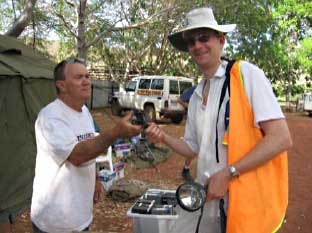 |
Support the Stop The Toad Foundation (Inc) |
|
MUSTER - TOAD TOTAL AT END OF WEEK
#4 = 34,604
|
|
Supported by |
 |
Web Manager: Dave Graham - Web hosting & scripts: Alex Varlakov http://ozup.com/ |



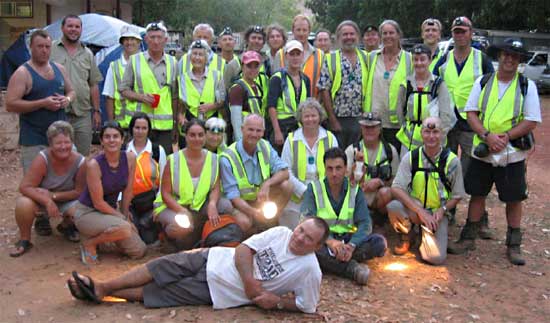
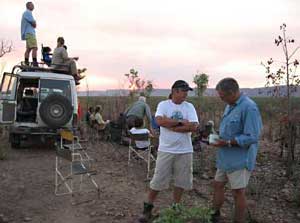
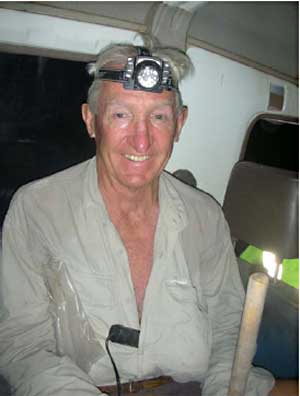
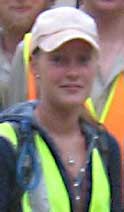 I
know on one hand it is crazy to drive out into the darkness,
walk through the bush and mud, surrounded by spiders and snakes,
the only weapon a torch – and try to catch toads. But
on the other hand it is great fun and absolutely exciting
and its doing something for the environment. Now, after I
have met many very nice people in the Toad Muster group, I
travel on. And I am sure, the next time I see a toad crossing
my way, I know what I have to do: STOP THE TOAD!
I
know on one hand it is crazy to drive out into the darkness,
walk through the bush and mud, surrounded by spiders and snakes,
the only weapon a torch – and try to catch toads. But
on the other hand it is great fun and absolutely exciting
and its doing something for the environment. Now, after I
have met many very nice people in the Toad Muster group, I
travel on. And I am sure, the next time I see a toad crossing
my way, I know what I have to do: STOP THE TOAD!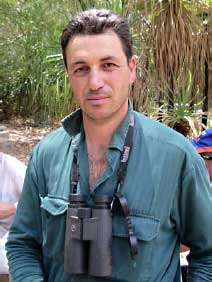 I
was at the Great Toad Muster 2006 from 23 Sept to 15 Oct as
a volunteer. I helped with collecting toads most nights.
I
was at the Great Toad Muster 2006 from 23 Sept to 15 Oct as
a volunteer. I helped with collecting toads most nights.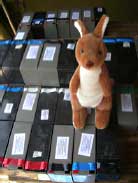 Chair
of the STTF board, Robert Edel is issued his gear by John
the Muster’s Quartermaster.
Chair
of the STTF board, Robert Edel is issued his gear by John
the Muster’s Quartermaster. 

















